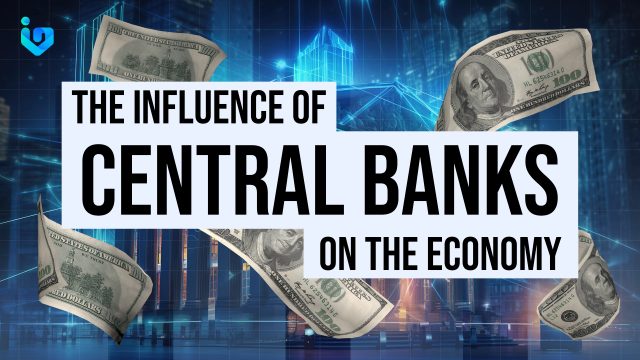Central banks are powerful institutions that play a vital role in shaping economic conditions. They have the responsibility of managing the money supply, setting interest rates, ensuring financial stability, and implementing monetary policy. In this article, we will explore how central banks influence the economy and why their actions matter for businesses and consumers.
What is a central bank?
A central bank is a financial institution given control over the production and distribution of money and credit. Its primary function is to manage the nation’s money supply (monetary policy), controlling inflation, printing money, setting interest rates, maintaining the health of the financial system, and ensuring economic stability.
Central banks are usually independent from the government, meaning that they are not subject to political interference or pressure. This allows them to pursue their objectives without being influenced by short-term political agendas or interests. However, central banks are still accountable to the public and the government. They have to explain and justify their decisions and actions.
How do central banks control the money supply?
Central banks control the amount of money circulating in the economy by using various tools, such as open market operations, reserve requirements, and interest rate adjustments.
Open market operations
This is the process of buying or selling government securities (such as bonds or treasury bills) in the open market. When the central bank buys securities, it pays with new money, increasing the money supply. When it sells securities, it takes money out of circulation, decreasing the money supply.
Reserve requirements
This is the percentage of deposits that commercial banks have to keep as reserves. The higher the reserve requirement, the less money banks can lend out, reducing the money supply. The lower the reserve requirement, the more money banks can lend out, increasing the money supply.
Interest rate adjustments
This is the rate at which the central bank lends money to commercial banks. The higher the interest rate, the more expensive it is for banks to borrow money. This discourages lending and reduces the money supply. The lower the interest rate, the cheaper it is for banks to borrow money. Thus, encouraging lending and increasing the money supply.
How do central banks influence the economy?
Central banks influence the economy by affecting the cost and availability of money and credit. In turn affecting the spending and investment decisions of businesses and consumers. By controlling the money supply and interest rates, central banks can influence the rate of inflation, the level of economic activity, and the exchange rate of the currency.
Inflation
This is the general increase in the prices of goods and services over time. Central banks aim to keep inflation low and stable. High and volatile inflation can erode the purchasing power of money, distort economic signals, and create uncertainty and instability. Central banks use monetary policy to manage inflation, by adjusting the money supply and interest rates. When inflation is above the target, the central bank tightens monetary policy. This is done by reducing the money supply and raising interest rates. When inflation is below the target, the central bank eases monetary policy. This makes borrowing and spending cheaper, stimulating the economy and raising inflation.
Economic activity
This is the level of production, consumption, and trade in the economy, measured by indicators such as gross domestic product (GDP), unemployment, and industrial output. Central banks aim to support economic growth and employment. They also use monetary policy to influence economic activity, by affecting the demand and supply of money and credit. When economic growth is strong, the central bank tightens monetary policy, by reducing the money supply and raising interest rates. This cools down the economy, preventing overheating and high inflation. When economic growth is weak, the central bank eases monetary policy, by increasing the money supply and lowering interest rates. This boosts the economy, preventing deflation and recession.
Exchange rate
This is the price of one currency in terms of another currency, determined by the supply and demand of currencies in the foreign exchange market. Central banks can affect the exchange rate of their currency, by changing the money supply and interest rates. When the central bank increases the money supply and lowers interest rates, the domestic currency becomes less attractive. This causes the currency to depreciate, meaning that it becomes cheaper relative to other currencies. The opposite also holds true. Higher rates often causes the domestic currency to appreciate.
Why do central banks matter for businesses and consumers?
Central banks matter for businesses and consumers, as their actions have direct and indirect effects on the economy and the financial system. By influencing the money supply, interest rates, inflation, economic activity, and exchange rates, central banks affect the cost and availability of credit, the profitability and competitiveness of businesses, the income and spending power of consumers, and the stability and confidence of the economy.
Cost and availability of credit
This is the price and quantity of loans and other forms of borrowing in the economy. Central banks affect the cost and availability of credit, by changing the interest rate and the money supply. When the central bank lowers the interest rate and increases the money supply, credit becomes cheaper and more abundant, making it easier for businesses and consumers to borrow and spend. This can stimulate economic growth and investment, but also increase the risk of excessive debt and inflation. When the central bank raises the interest rate and decreases the money supply, credit becomes more expensive and scarce, making it harder for businesses and consumers to borrow and spend. This can slow down economic growth and investment, but also reduce the risk of overheating and inflation.
Profitability and competitiveness of businesses
This is the ability of businesses to generate revenues and profits. Central banks affect the profitability and competitiveness of businesses, by affecting the inflation, economic activity, and exchange rate of the currency. When the central bank keeps inflation low and stable, businesses can plan and invest with more certainty and confidence, as they face lower costs and risks. They can also impact businesses by causing catalysts in the forex market. A stronger currency can make exports more expensive and imports cheaper, hurting exporters and benefiting importers. A weaker currency can make exports cheaper and imports more expensive, helping exporters and hurting importers.
Income and spending power of consumers
This is the amount and value of money that consumers earn and spend in the economy. Central banks affect the income and spending power of consumers, by affecting the interest rates, inflation, economic activity, and exchange rate of the currency. When the central bank lowers interest rates and increases the money supply, consumers can benefit from lower borrowing costs and higher asset prices, as they can access cheaper credit and increase their wealth. The central bank keeps inflation low and stable, consumers can preserve the purchasing power of their money, as they face lower prices and costs. As they support economic growth and employment, consumers can enjoy higher income and job security, as they have more opportunities and confidence to work and earn. When the central bank influences the exchange rate of the currency, consumers can gain or lose purchasing power, depending on whether the currency appreciates or depreciates. A stronger currency can make foreign goods and services cheaper, increasing the purchasing power of consumers. A weaker currency can make foreign goods and services more expensive, decreasing the purchasing power of consumers.
Stability and confidence of the economy
This is the degree of certainty and trust that the economy and the financial system are functioning well and can withstand shocks and crises. Central banks affect the stability and confidence of the economy, by ensuring the financial stability of the banking system, implementing credible and transparent monetary policy, and coordinating with other central banks and authorities. When the central bank ensures the financial stability of the banking system, it prevents bank failures and systemic risks, by monitoring and regulating the financial institutions, providing liquidity and emergency loans, and acting as a lender of last resort. As they implement credible and transparent monetary policy, they enhance the effectiveness and predictability of their actions.
Conclusion
Central banks are influential institutions that have a significant impact on the economy and the financial system. They control the money supply, set interest rates, ensure financial stability, and implement monetary policy. By doing so, they influence the inflation, economic activity, and exchange rate of the currency. Their actions affect the cost and availability of credit, the profitability and competitiveness of businesses, the income and spending power of consumers, and the stability and confidence of the economy. Central banks matter for businesses and consumers, as they shape the economic conditions and environment in which they operate and live.

